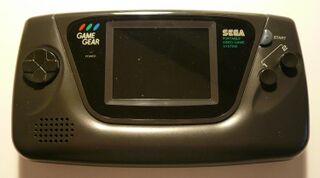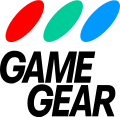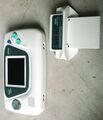Sega Game Gear
From Sega Retro

| |||||||||||||||||||||||||||||||||||||||||||||||||||||||||||||||||
| Sega Game Gear | |||||||||||||||||||||||||||||||||||||||||||||||||||||||||||||||||
|---|---|---|---|---|---|---|---|---|---|---|---|---|---|---|---|---|---|---|---|---|---|---|---|---|---|---|---|---|---|---|---|---|---|---|---|---|---|---|---|---|---|---|---|---|---|---|---|---|---|---|---|---|---|---|---|---|---|---|---|---|---|---|---|---|---|
| Manufacturer: Sega | |||||||||||||||||||||||||||||||||||||||||||||||||||||||||||||||||
|
The Sega Game Gear (セガゲームギア) is a handheld video game console developed by Sega and released in late 1990 as a response to Nintendo's Game Boy handheld . It is a full colour console and was Sega's first attempt to compete in the handheld games market (the second being the Sega Nomad — a handheld Sega Mega Drive). In South Korea it is known as the Handy Gam*Boy (핸디겜보이).
Contents
Hardware
- See also: Game Gear consoles
The Sega Game Gear is a "portable" device which was designed to address problems with Nintendo's Game Boy. It is held lengthwise at the sides (preventing the cramping of hands which plagued Nintendo's system) and has a backlit, colour LCD screen, allowing for clearer and more vibrant visuals than its main rival.
Similarly to the Sega Mega Drive, which at the time was Sega's main focus in the home console market, the Sega Game Gear is derived from the earlier Sega Master System. Unlike the Mega Drive, however, the Game Gear is largely identical to the Master System, the major difference being a VDP capable of displaying palettes consisting of a wider variety of colors, and the playback of stereo sound. Game Gear games traditionally run at a smaller resolution too, although with a screen built similarly to televisions of the era, the Game Gear is fully capable of playing games in higher resolutions.
Like the Master System, the Game Gear features a D-Pad and two buttons, ![]() and
and ![]() , but also adds a third, START . This is one button short of a Game Boy.
, but also adds a third, START . This is one button short of a Game Boy.
Unfortunately, due to technical limitations of the era, the Game Gear demands six AA batteries to be played on the go, of which the fluorescent backlight on the LCD screen will eat through in three to five hours (though a battery pack provides longer playtime). Furthermore, the system gives off more heat than the Game Boy, often leading to "sweaty palms" after prolonged use. The system was also considered not to be very "portable" - it's bulky size means it does not fit in many pockets, and the power-draining backlight of the LCD screen (which cannot be turned off) meant Game Gears were unusable after a short period of time. An AC adaptor can be plugged into the system so that it runs off the mains, but this was not considered practical for consumers of the day.
Game Gears were also manufactured at a time where capacitor problems were rampant across the electronics industry. As a result, screen and audio failures are common, and fixes are not always simple.
Technical Specifications
- Main Processor: Zilog Z80 (8-bit)
- Processor Speed: 3.579545 MHz (same as NTSC colorburst)
- Resolution: 160 x 144 pixels
- Colors Available: 4,096
- Colors on screen: 32
- Maximum Sprites: 64
- Sprite Size: 8x8
- Screen Size: 3.2 Inches
- Audio: Texas Instruments SN76489
- RAM: 24 KB
History
Development
Development on the Sega Game Gear began in 1989, with the codename Mercury. At the time, Nintendo's Game Boy was proving to be a huge success, despite its awkward shape and four shades of green/yellow. Sega felt that consumers may buy a handheld that fixed these problems, and so the Game Gear was born. It was originally announced at Tokyo Toy Show 1990 on the 7th June 1990.
The Game Gear was not the first attempt at rivaling the Game Boy - this title goes to the Atari Lynx, released in October 1989 with similar goals in mind. The Lynx's existence does not appear to have influenced the Game Gear's development, although the two share similar advantages and shortcomings over Nintendo's console.
Release
Japan
The Game Gear was first released in Japan on October 6, 1990 with launch titles Columns (bundled with the unit), Super Monaco GP, and Pengo. 40,000 units were reportedly sold in Japan in its first two days of sale, and within a month, 600,000 had been shipped, but Sega struggled to keep the momentum going and sales tailed off by the middle of the decade.
Despite its strong launch, Japanese consumers are thought not have been too interested in the handheld, and early units suffered from several hardware faults. By the time of the "second wave" of Game Boy games materialised, prompted by the hugely successful release of Pocket Monsters in early 1996, the Game Gear was in a distant second, though limited software support continued until the release of G Sonic in December of that year. Despite strong support for the PC Engine in the region, the PC Engine GT, a handheld version of the aforementioned console, is not thought to have performed admirably and would have likely trailed in third place.
Japan was the only region to receive coloured systems (with one exception). Initial units were black, much like the rest of the world, but later, yellow, blue, red and white units were released, as well as several special versions tied to game releases.
North America
North America received the Game Gear in 1991 (after a brief market test in New York and Los Angeles) and Sega of America immediately went on the offensive, attacking the Game Boy at almost every opportunity for its limited colour palette with amusing and bizarre TV spots. This continued throughout the first half of the 1990s despite again trailing in second place, even poking fun at the existence of the coloured Game Boy console lineup of 1995 (i.e. those with coloured shells, not with coloured screens).
The Game Gear debuted at a time when a rival, the Atari Lynx, was taking an (albeit limited) share of the market from Nintendo, but while the Game Gear never topped the Game Boy, it did manage second place with its competitive price and trounced Atari's efforts with a larger library of games. The NEC TurboExpress, as in Japan in PC Engine GT form, buckled under its high asking price and poor marketing and likely finished fourth. Many of the Game Gear's flaws in regards to screens and battery life also applied to the Lynx and TurboExpress (although the Lynx drained its batteries in slightly less time than Sega's - 4-5 hours).
Blue Game Gears were bundled with copies of World Series Baseball and The Lion King in this region. They are considerably rarer than the black models, and a darker shade than the Japanese blue models.
Majesco, who were given the rights to distribute older Sega consoles, re-released the Game Gear in February 1999 at an asking price of $29.95 (games being priced at $9.95)[6]. These Game Gears have lightly improved specifications, including a better screen and longer battery life, but can run the entirety of the older back catalogue. Majesco Game Gears can be identified by their non-coloured logos and purple start buttons. They are incompatible with the TV Tuner.
Europe
Though a reasonably popular handheld in Europe, the Game Gear again played second best to the Game Boy, making it the first Sega console in that region to make less money than Nintendo. Sega Europe curiously put a greater emphasis on the Game Gear's TV Tuner, bundling it with consoles and using it as a marketing tactic against the system's only rival, however the Game Gear struggled for similar reasons as it had in North America - poor battery life, awkward design choices and a smaller library of games.
South Korea and Asia
The Game Gear is known to have been released in these markets but its performance is not fully understood. More than likely the system failed to get off the ground due to high asking prices.
As with later Sega consoles, third-party support for the Game Gear was in short supply, particularly from Japanese developers. However, due to the hardware similarities, many early Game Gear games were modifications of Sega Master System games made to take advantage of the larger palette capabilities and smaller screen size. This meant many companies could convert their Master System lineup in to Game Gear titles fairly easily (and vice versa), but this only applied to companies supporting Europe, as by the time the Game Gear was released, the Master System had been discontinued in Japan and North America.
Decline
Typically one can assume the Game Gear always stood in a distant second place when compared to the Game Boy, but this does not seem to be entirely true for many regions of the world, with Sega even claiming a 51% share of the handheld market by early 1995. However, despite an extensively aggressive Western marketing strategy for much of the early 90s, the system's presumed lukewarm acceptance in Japan led to Sega prioritising their Sega Mega Drive, Sega 32X and Sega Saturn consoles.
While the Game Boy became more portable, streamlining its design and adopting better screen and battery technology, no significant changes were made to the Game Gear to overcome its faults. The combination of poor design choices and poor third-party support led to the Game Gear's eventual decline and discontinuation in 1997, although much of this seems to have been driven by a desire to concentrate on the struggling Sega Saturn and future projects.
Approximately 390 Game Gear games were produced, with 11 million Game Gear units sold worldwide.
After the Game Gear's discontinuation, Sega did not attempt to re-enter the handheld console market, instead choosing to become a third-party developer for other handhelds. Sega of America immediately moved to supporting Tiger Electronics's Game.com and R-Zone units, and by the end of the decade Sega of Japan backed the Neo Geo Pocket Color and licensed games to Bandai for the WonderSwan and to Media Factory for Nintendo's Game Boy Color. By the end of 2000 Sega had become a licensed third-party developer for Nintendo's handhelds, releasing Chu Chu Rocket! as a launch title for the Game Boy Advance.
Legacy
The next generation of Game Boy rivals, such as the Neo Geo Pocket Color, the WonderSwan and Game.com all opted to follow in Nintendo's footsteps - cutting back on performance-degrading backlit screens and demanding graphics, and instead utilising monochrome screens or specifications akin to the 1998 release of the Game Boy Color. Arguably Nintendo themselves did not surpass the Game Gear's 1990 specifications until 2001 with the launch of the Game Boy Advance.
Game Gear games are offered in the Nintendo 3DS's Virtual Console service.
Games
- See List of Game Gear games for a complete list.
Launch titles
Japan
North America
- Castle of Illusion Starring Mickey Mouse
- Columns
- G-Loc: Air Battle
- Psychic World
- Revenge of Drancon
- Super Monaco GP
Europe
- Castle of Illusion Starring Mickey Mouse
- Columns
- Dragon Crystal
- G-Loc: Air Battle
- Psychic World
- Super Monaco GP
- Wonder Boy
Brazil
Gallery
JP model (Coca Cola Kid edition (Model #3210CR))
JP model (Magic Knight Rayearth edition (Model #HGG-3210 RAY))
JP model (Virtua Fighter Mini edition)
- GGSmoke.jpg
JP model (Smoke)
Promotional material
Print advertisements
- GameGear US PrintAdvert 3.jpg
US (pre-launch)
- GameGear US PrintAdvert.jpg
US (launch)
- GameGear US PrintAdvert SuperSonicSavings.jpg
US (Super Sonic Savings)
- GameGear US PrintAdvert 2.jpg
US
- GameGear UK PrintAdvert.jpg
UK
- GG FR PrintAdvert.jpg
FR (1)
- GG FR PrintAdvert 2.jpg
FR (2)
- GameGear PreciosSega06 ES PrintAd 1992-04.jpg
ES (1)
- GameGear SoftwareSega3 ES PrintAd 1992-11.jpg
ES (2)
- GameGearTVPack ES PrintAd 1993-05 2.jpg
ES (3; variation 2)
- GameGear ES PrintAd 1993-09.jpg
ES (4)
- GameGear ES PrintAd 1993-10.jpg
ES (5)
- GameGear ES PrintAd 1993-12 1.jpg
ES (6)
- GameGear ES PrintAd 1993-12 2.jpg
ES (7; variation 1)
- GameGear ES PrintAd 1993-12 3.jpg
ES (7; variation 2)
- GameGear ES PrintAd 1994-04.jpg
ES (8)
- GameGear ES PrintAd 1994-07.jpg
ES (9; variation 1)
- GameGear ES PrintAd 1994-09.jpg
ES (9; variation 2)
- GameGear ES PrintAd 1995-07.jpg
ES (10)
- GameGear ES PrintAd 1995-12.jpg
ES (11)
- GameGear BR PrintAdvert.jpg
BR
Television advertisements
- GG Gear Up Commercial.flv
US (1991)
- GG Men From Boys Commercial.flv
US
- 1992 Sega Game Gear Spinach Commercial.flv
US (1992)
- GG One Color Electronics Commercial.flv
US (1993)
- GG Squirrel Commercial.flv
US (1994)
US (1995?)
- GG Japanese Color Commercial 1.flv
JP1 (1990)
- GG Japanese Color Commercial 2.flv
JP2 (1990)
- GG Takahashi Yumiko Hat Commercial.flv
JP3 (1991)
- GG Takahashi Yumiko Train Commercial.flv
JP4 (1991)
- GG Portuguese Commercial.flv
Portuguese (1994)
- 1994 Spanish Game Gear Commercial.flv
Spanish (1994)
- French Game Gear commercial.flv
French
- Australian Sega Game Gear Commercial 1992.flv
Australian (1992)
External links
- Console Database - Sega Game Gear info and FAQs
- SMS Power - Technical information and more on the Game Gear and its bigger brother, the Master System
References
| Sega Home Video Game Systems | ||||||||||||||||||||||||||||
| 83 | 84 | 85 | 86 | 87 | 88 | 89 | 90 | 91 | 92 | 93 | 94 | 95 | 96 | 97 | 98 | 99 | 00 | 01 | 02 | 03 | 04 | 05 | 06 | 07 | 08 | 09 | 10 | 11 |
|---|---|---|---|---|---|---|---|---|---|---|---|---|---|---|---|---|---|---|---|---|---|---|---|---|---|---|---|---|
| SG-1000 | SG-1000 II | Mega Drive | Mega Drive II | |||||||||||||||||||||||||
| SC-3000 | Mega-CD | Mega-CD II | Genesis 3 | |||||||||||||||||||||||||
| Sega Mark III | 32X | Dreamcast | ||||||||||||||||||||||||||
| Master System | Master System II | |||||||||||||||||||||||||||
| AI Computer | Game Gear | |||||||||||||||||||||||||||
| Saturn | ||||||||||||||||||||||||||||
| Pico | Beena | |||||||||||||||||||||||||||
| Sega Game Gear | |
| Topics | Sega Game Gear | History | Magazine articles | Promotional material | Merchandise |
|---|---|
| Hardware | Japan | North America | Western Europe | Eastern Europe | Asia | South America | Australasia | Africa Wide Gear | Fun Play 20-in-1 |
| Add-ons | Pro Action Replay | Game Genie | X-Terminator | Master Gear Converter (Gear Master | Nuby Converter) | Stereo FM Tuner | TV Tuner |
| Cases | Carry-All | Deluxe Carry-All Case | Gear Bag | Holster Case | Standard Carrying Case | Soft Case | Third Party (Play & Carry Case) |
| Accessories | A/V Cable | Battery Pack | Car Adaptor | Car Antenna | Cleaning Gear | Gear-to-Gear Cable | PowerBack (Third Party) | Screen Magnifier (Wide Gear | Super Wide Gear | Third-Party) |
| Development Tools | Sega Game Gear Development Board |


















